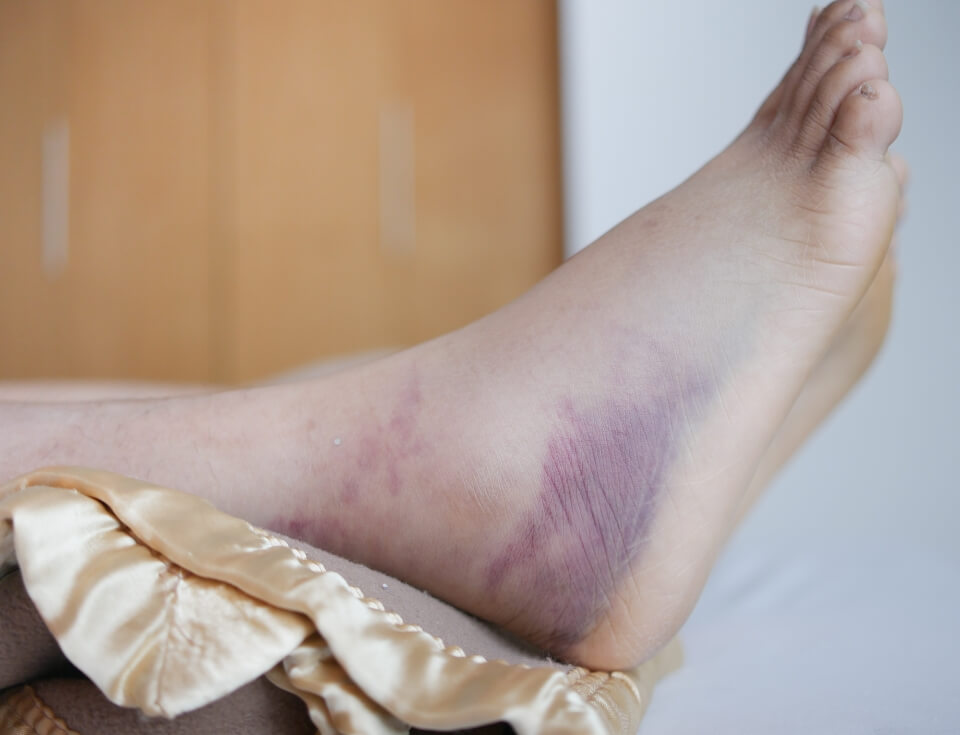Ankle sprain Perth
What are ankle sprains?
Ankle sprains are common injuries that happen when you suddenly twist or fall on your ankle, or when you land awkwardly after jumping. When this happens, you’ll feel pain, swelling, tenderness, bruising, stiffness, and you might find it hard to put weight on your ankle.
When we talk about an ankle sprain, it means that the ligaments, which are like bands that hold bones together, get stretched or torn.
These ligaments are important for keeping your joints stable, so when they’re injured, it can make your ankle feel wobbly or unstable, especially if it happens often. The most typical kind of sprain is when the ligaments on the outside of the ankle get hurt.

The seriousness of an ankle sprain can vary.
- A grade 1 sprain means the ligaments are mildly stretched.
- Grade 2 is when they’re partially torn, causing more pain and swelling.
- Grade 3 is the worst, with the ligaments completely torn, leading to severe pain, swelling, and instability in the ankle.
When your ankle is often unstable, it can hurt the cartilage. Cartilage is a tough, flexible tissue found in your joints, like the ankle. Because of the instability, the cartilage gets too much pressure, which wears it down over time.
Some people are more likely to sprain their ankles. For example, if your heels naturally turn inwards a bit (that’s called hindfoot varus), it can make it easier for your ankle to twist. Also, if you’re double-jointed and your ligaments are looser than usual, you might be more prone to sprains.
Understanding ankle ligaments
Ankle ligaments hold your ankle bones together. When you twist or roll your ankle, these ligaments can stretch or tear, causing a sprain.
The ligaments on the outside of your ankle are more likely to get sprained than the ones on the inner side. Let’s focus on the lateral ligament complex:
- ATFL (Anterior Talofibular Ligament): This ligament connects the tip of your leg bone (fibula) to the front of your foot bone (talus). It’s often the one that gets injured in ankle sprains.
- CFL (Calcaneofibular Ligament): This ligament connects the tip of your fibula to your heel bone (calcaneus). It’s usually injured along with the ATFL during ankle sprains.
- PTFL (Posterior Talofibular Ligament): This ligament links the tip of your fibula to the back of your foot bone (talus). Injuries to this ligament are rare but indicate a severe ankle injury when they happen.
The ligaments on the inside of your ankle are called the medial ligaments. The main one is called the deltoid ligament. It helps keep the inner part of your ankle stable.
A high ankle sprain involves tearing the ligaments between the two bones in your lower leg, just above the ankle joint, which is different from the more common lateral or medial ligament sprains.
Ankle surgery Perth
How are ankle sprains treated?
Most ankle sprains can be treated without surgery, and the ligaments typically heal well on their own. The initial treatment usually involves RICE:
- Rest: Avoid moving or putting weight on your ankle to reduce pain and prevent further injury. You may need crutches.
- Ice: Apply ice for 20 minutes several times a day to reduce swelling and pain. Wrap the ice pack in a towel.
- Compression: Use an elastic bandage to wrap your ankle to reduce swelling and bruising.
- Elevation: Keep your ankle elevated above your heart to decrease swelling.
If you can walk after the sprain, you might not need to wear an ankle brace. But if the sprain is severe and you can’t put weight on it, wearing a boot can help. We will give you medicine to reduce pain and swelling.
Physiotherapy is important. You’ll need to do exercises to make your ankle muscles stronger. In some cases, you might need to wear an ankle brace while exercising until your muscles are strong enough to support your ankle on their own.
Sometimes, ankle surgery is needed for patients with severe ligament tears or long-term ankle problems. In these cases, the type of ankle surgery required depends on various factors, including the cause and seriousness of the injury, as well as your individual situation.

Surgery might also be needed if there’s damage to the cartilage or other parts around the ankle.
Surgery for ankle sprains
There are a few procedures for ankle sprains:
In ankle reconstruction small anchors with attached sutures are used to secure the ligaments back to the bone. If the ligaments cannot be repaired, reconstruction may be done using a tendon from another part of the body or a synthetic ligament.
Ankle reconstruction is done with general anaesthesia and often requires an overnight hospital stay. The goal is to repair damaged ligaments by reattaching them to the fibula bone using absorbable anchors for stability during healing.
Here, we explain ankle reconstruction in full detail.
How to prevent ankle sprains?
To prevent ankle sprains, wear supportive footwear, perform ankle strengthening exercises, maintain proper balance and flexibility, and use caution during physical activities to avoid sudden twists or falls.
How long does it take to recover from an ankle sprain?
Recovery time for an ankle sprain varies depending on the severity. Mild sprains may heal within a few weeks with rest, ice, compression, and elevation (RICE), while severe sprains may take several months to fully recover, requiring physiotherapy and gradual return to activities.
When should I see an ankle surgeon for an ankle sprain?
Consult an ankle surgeon if you experience severe pain, swelling, instability, or difficulty bearing weight on the ankle, or if symptoms persist despite conservative treatments like RICE.
Can ankle sprains lead to long-term complications?
Yes, untreated or poorly managed ankle sprains can lead to chronic ankle instability, recurrent sprains, arthritis, and other long-term complications, emphasising the importance of proper diagnosis and treatment.
Is ankle surgery necessary for all ankle sprains?
Ankle surgery is typically reserved for severe ankle sprains that do not respond to conservative treatments, such as rest, physical therapy, and immobilisation. Your ankle surgeon will assess your individual case to determine the most appropriate course of action.
Ankle surgeon Perth
Why The Foot & Ankle Centre?
At the Foot & Ankle Centre, our orthopaedic surgeon specialises in ankle surgery.

You are welcome to make an appointment at The Foot & Ankle Centre. We try to see patients as quickly as possible.


